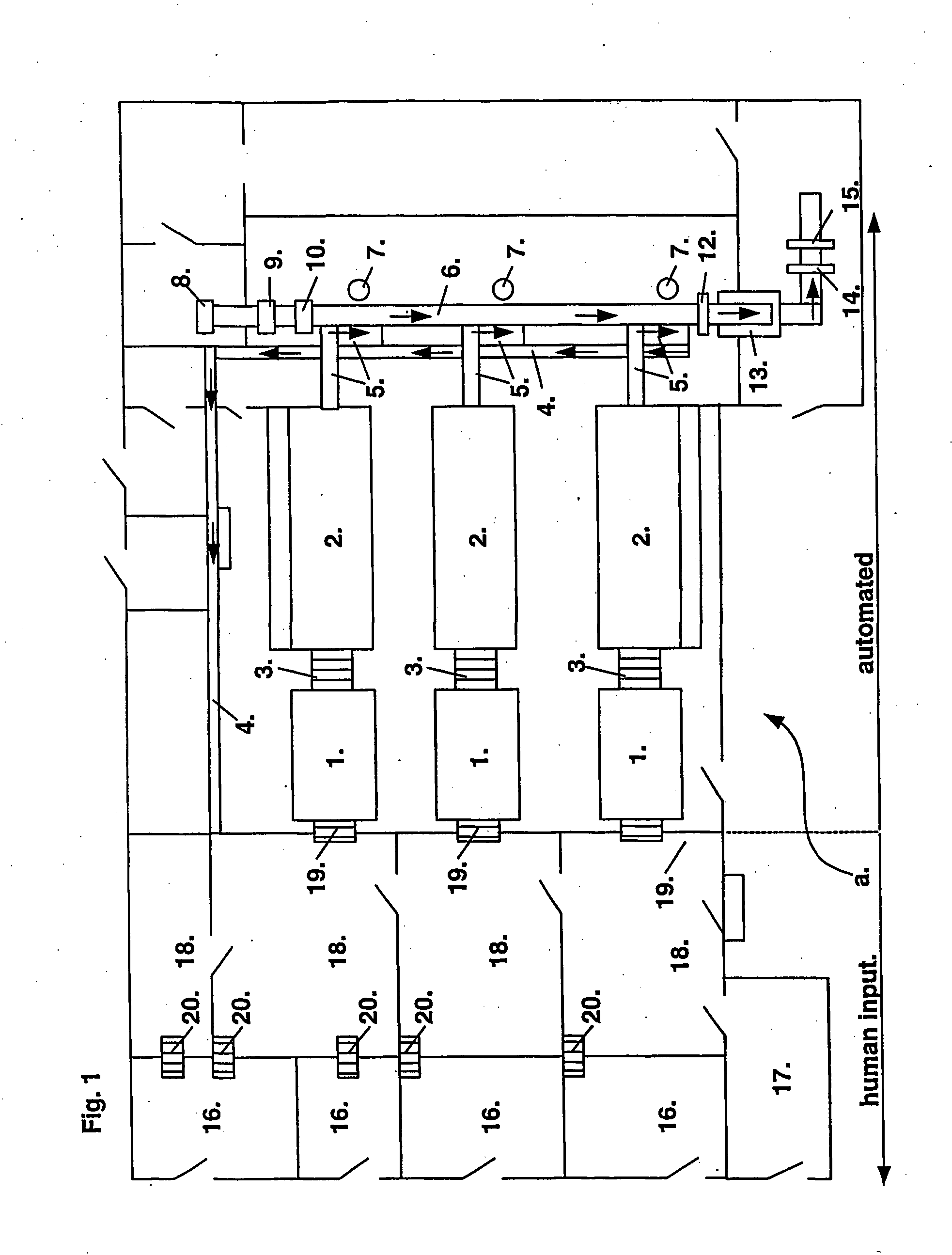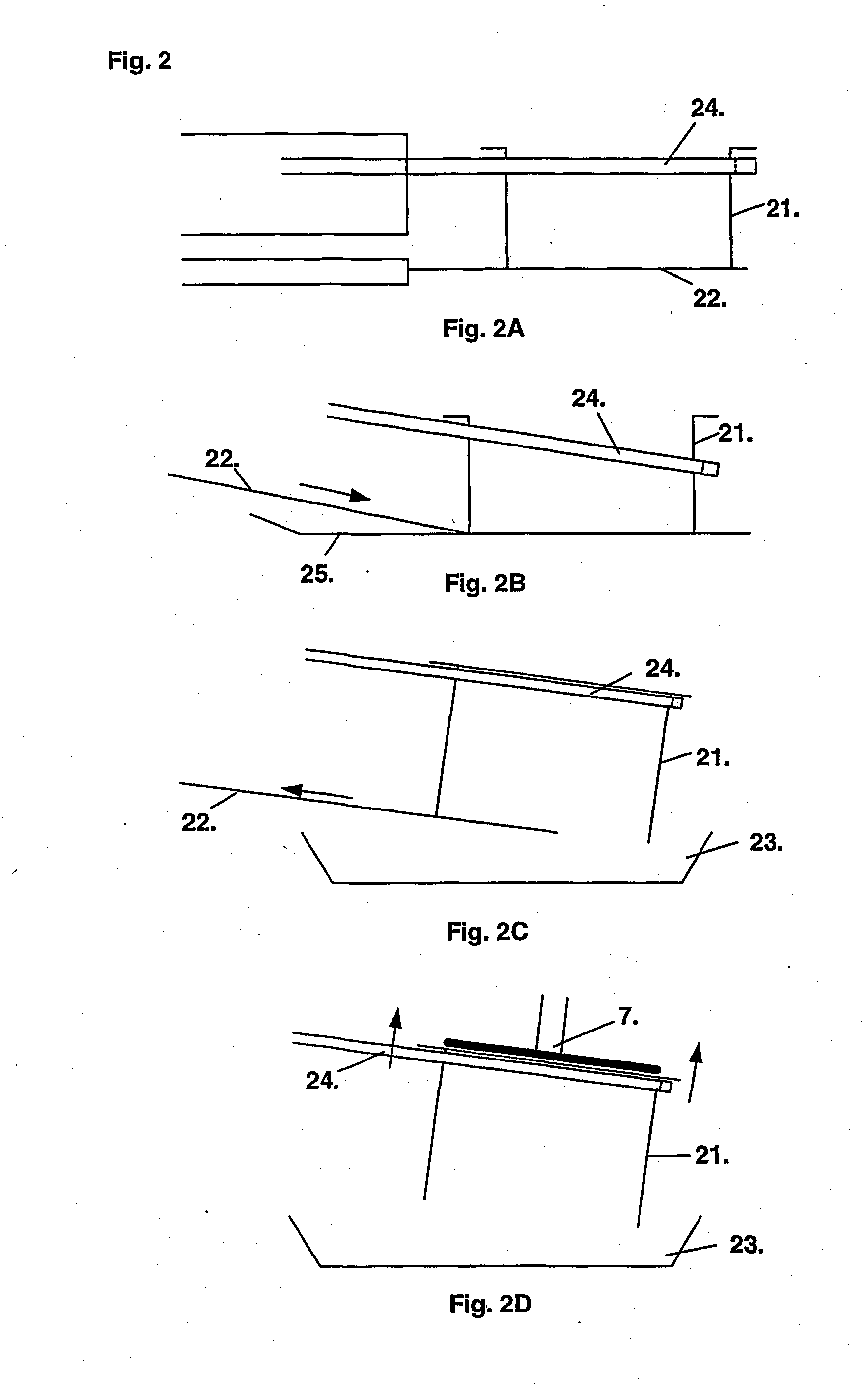Automated production of packaged cooked meals
a technology for cooking meals and automatic production, applied in the field of automatic production of cooked meals, can solve the problems of unappetising meals, unappetising meals, and lack of time in busy schedules for people to spend the necessary time, and achieve the effect of reducing the chance of a meal
- Summary
- Abstract
- Description
- Claims
- Application Information
AI Technical Summary
Benefits of technology
Problems solved by technology
Method used
Image
Examples
example 1
Lamb Shanks
[0163] Preparation of Meat
[0164] The shanks are cut to fit moulds. Rectangular moulds are greased, then the shanks are placed in the rectangular moulds. The shanks are lightly sprayed with oil, then sprinkled with salt and pepper. The shanks contained in the mould are placed into the oven on setting ‘LAMB SHANK’.
[0165] Preparation of Starch Portion
[0166] Three kilos of potato are diced onto a large tray. Fifteen grams salt, five grams pepper, 100 mls of olive oil are added and mixed thoroughly. The potatoes are placed in the precook oven on setting ‘CRUSHED POTATO 1’. The precooked potatoes are placed into mixers and 100 mls of olive oil and 5 grams of Tuscan seasoning are added. 185 gram portions of seasoned potatoes are placed into greased double round moulds.
[0167] Place in oven on setting ‘CRUSHED POTATO 2’.
[0168] Vegetable Portion
[0169] Green beans are washed and bound with raffia in 100 gram bundles. The beans are then placed into greased rectangular moulds a...
example 2
Chicken Breasts
[0172] Preparation of Meat
[0173] The chicken breasts are trimmed to size, then wrapped with streaky bacon. Rectangular moulds are greased and then filled with chicken. The breast is lightly sprayed with oil, then sprinkled with salt and pepper. A small amount of sage is sprinkled onto chicken breast, then it is placed into the oven on setting ‘CHICKEN BREAST’.
[0174] Preparation of Starch Portion
[0175] Three kilos of potato are sliced into a large bowl. Seventy grams garlic, 30 grams salt, 10 gm pepper, 500 mls of cream are added and mixed thoroughly. The potato is then placed on a greased oven tray and precooked in an oven on setting ‘GRATIN POTATO 1’.
[0176] After pre-cooking the potatoes are pressed until they are flat, the potatoes are then cut into squares and placed into greased rectangular moulds, and placed into the oven on setting ‘GRATIN POTATO 2’.
[0177] Vegetable Component
[0178] Eighty grams of broccoli into placed into rectangular moulds, and placed i...
example 3
Lamb Rump
[0181] Preparation of Meat
[0182] The lamb rump is trimmed to size and place in greased rectangular moulds, then lightly sprayed with oil. The lamb rump is then sprinkled with salt and pepper, and a small amount of sage. The lamb rump is then placed into the oven on setting ‘LAMB RUMP’.
[0183] Preparation of Starch Portion
[0184] Three kilos of pumpkin are diced and mixed with 15 grams salt, 5 grams pepper and 100 mls of olive oil. The pumpkin is then placed in an oven dish and precooked on setting ‘PUMPKIN GALLETTE 1’.
[0185] The precooked pumpkin is then placed into a mixer and 100 mls of egg yolk and half a cup of chives are added and mixed. The mixture is then spooned into oval moulds and placed into the oven on setting ‘PUMPKIN GALLETTE 2’.
[0186] Vegetable Component
[0187] 250 mls of cream, 160 grams egg yolk, 5 grams pepper, and 16 grams salt are blended in a food processor. 450 grams spinach are washed and drained and blended for 30 seconds. The spinach and liquid ...
PUM
 Login to View More
Login to View More Abstract
Description
Claims
Application Information
 Login to View More
Login to View More - R&D
- Intellectual Property
- Life Sciences
- Materials
- Tech Scout
- Unparalleled Data Quality
- Higher Quality Content
- 60% Fewer Hallucinations
Browse by: Latest US Patents, China's latest patents, Technical Efficacy Thesaurus, Application Domain, Technology Topic, Popular Technical Reports.
© 2025 PatSnap. All rights reserved.Legal|Privacy policy|Modern Slavery Act Transparency Statement|Sitemap|About US| Contact US: help@patsnap.com



